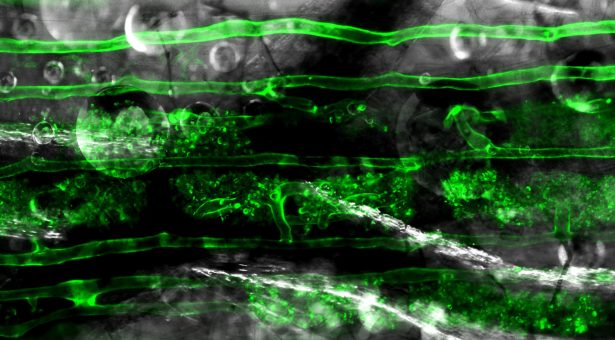The enemy within: how a killer hijacked one of nature’s oldest relationships

Researchers have discovered how a notorious pathogen may have hijacked one of nature’s most enduring mutual relationships.
The work sheds new light on a long-standing enigma about why plants possess genes that appear to be detrimental to their well-being.
It’s long been known that the Mildew Locus O (MLO) gene causes the majority of major crops to be susceptible to the fungal leaf pathogen powdery mildew. Loss of the gene causes durable and robust resistance to the pathogen.
But if this gene is disadvantageous to the host, why has it been conserved throughout evolutionary history? Does this susceptibility factor also fulfil some other beneficial role?
In a joint project between the John Innes Centre and the Shanghai Institute of Plant Physiology and Ecology, scientists found that the MLO gene needed by the powdery mildew pathogens is also used by symbiotic mycorrhizal fungi that help plants obtain nutrients from the soil.
Mycorrhizal fungi are beneficial soil microorganisms that establish symbiotic interactions in plant roots and contribute to nutrient uptake. Powdery mildews are serious leaf fungal pathogens that infect many different plant genera and cause significant crop losses in agriculture.
Importantly, the MLO gene and mycorrhizal symbiosis appeared very early in the evolution of land plants, millions of years before the occurrence of powdery mildew fungi.
In this study, experiments showed that mycorrhizal colonisation was reduced in mutant plants of barley, wheat and Medicago truncatula which did not express the MLO gene. This was accompanied by a pronounced decrease in the expression of many key genes required for accommodation of arbuscular mycorrhizal fungi inside plant cells. The findings suggest the primary role for MLO in flowering plants is in colonisation by the arbuscular mycorrhizal fungi, and that this role has been appropriated by powdery mildew.
The MLO gene is present in a wide variety of plants including important crops such as rice, wheat and legumes. The results have important implications for crop improvement and for sustainable agriculture to enhance beneficial mycorrhizal interactions while reducing losses from disease.
“The MLO gene has been widely studied for its role in powdery mildew resistance, although its ancestral role has remained elusive,” explains first author Dr Catherine Jacott.
“Since mycorrhizal fungi and powdery mildew respectively infect root and shoot, it may be possible to generate cereals that could fully support mycorrhiza while remaining non-hosts for powdery mildew.”
- The study: ‘Mildew Locus O facilitates colonization by arbuscular mycorrhiza in angiosperms‘, appears in New Phytologist journal
Picture credit – Henry Driver, commissioned by Essex County Council. Imagery from a three dimensional illuminated sculpture created in response, and celebrating Cressing Temple Barns’ grand history of grain storage. It uses images of symbiotic relationship between crop roots and arbuscular mycorrhizal fungi, where the root cells are colonised by the fungi, creating arbuscules which allow nutrient exchange with the plant.
Catherine Jacott’s PhD was supported by the Biotechnology and Biological Sciences Research Council (BBSRC) Norwich Research Park Bioscience Doctoral Training Grants BB/J014524/1 and BB/M011216/1.
The John Innes Centre and the Shanghai Institute of Plant Physiology and Ecology collaborate as part of the CAS-JIC Centre for Excellence in Plant and Microbial Sciences (CEPAMS).



